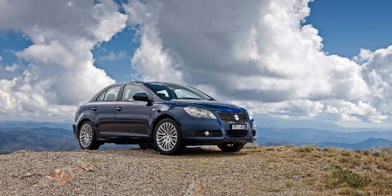Suzuki's greatest strength was its weakness when it sat down to plot a way into the New Zealand market for its first mid-sized global sedan, the Kizashi.
It was a small-car and SUV specialist, had been since day one. Now it had a medium-sized sedan to sell. Not just a four-door but a "world-class premium" four-door with "driving dynamics to match the best of Europe".
It needed a gimmick, something that hadn't been done before, a way to draw attention to its move from last Monday into a new segment.
Marketing manager Tom Peck and chief executive Bill Grice got together with Suzuki NZ advertising agency Promotus to target Air New Zealand.
The result was new ground for the ad industry: the Suzuki and Kizashi brand printed across the bottom of every e-ticket issued by Air New Zealand, with Kizashi brochures in Koru lounges and Koru car parks.
"The agreement with Air New Zealand is for two months with the right of renewal after that," says Peck.
"It's the first time e-ticket advertising has been done in New Zealand. Air NZ issues between 150,000 and 300,000 e-tickets a month and Kizashi is on every one."
Peck says Suzuki especially wanted to target the business sector with the four-door the company rates as a premium product, despite its aggressive entry-level price of $35,990.
"Kizashi is an unknown product and most people do not associate Suzuki with the word premium," he says.
"But we have a high-brand profile in New Zealand at present and the best-ever market share. We want to take advantage of that.
"This is the most lavishly equipped Suzuki ever offered in New Zealand. For example, the automatic headlamps incorporate a newly developed optical sensor that turns on the headlights when the car is about to enter a tunnel or darkened building but leaves them off when it passes under a relatively short overhang such as a bridge."
Suzuki has done particularly well in New Zealand with the Swift hatchback. It was the carmaker's first world car, in 2005. It believes there is much more potential here and aims to sell around 50 Kizashis a month, or around 300 before the end of the year. It is aiming the car at pretty much everything - Toyota Camry, Ford Mondeo, Mazda6, Honda Accord, Audi A4 and BMW 3-Series.
"We will need to take customers away from other brands to meet the sales targets for Kizashi," says Peck.
"It's the company's flagship passenger model and we are aiming it at the customer looking for a slightly more premium feel."
Kizashi is a Japanese word meaning "prelude" or "foretaste".
The name symbolises the change within Suzuki as it seeks to further expand its model range across 190-odd countries and beyond 3.2 million annual sales.
Before Kizashi it had nothing to offer Suzuki loyalists, those who had gone from one hatchback to another. Now it has. Kizashi also enables Suzuki to show off its technological know-how.
Suzuki began work on the Kizashi in 2004, setting out to combine sporty handling with ride comfort, a mix of the best of Japan and Europe. It ran prototypes over Germany's autobahns, Switzerland's mountain passes, England's cobbled roads and the high-speed Nurburgring's twists and turns. Cold weather tests were done in Minnesota, hot weather in California's Death Valley. It even came to New Zealand for braking and traction control tests. All up, Suzuki spent more than $2 billion on development.
A constant challenge for development engineers since the project began in 2004 was scepticism inside and outside Suzuki about whether they could produce such a car.
But the doubts only inspired them, says the company. The car so far has received high praise, especially for its drivability.
The price isn't bad, either - $35,990 for the GLX six-speed manual, $37,990 for the GLX automatic with CVT, and $42,990 for the leather-lined Ltd automatic with CVT. Equipment and safety levels are up there, too.
"At this pricing we are very excited about the prospects for Kizashi," says Suzuki NZ technical chief Rodney Brown.
"Our decision to price the GLX Kizashi below $40,000 breaks a significant price point.
"And when we compare our Ltd version, most of our competitors are hitting close to $50,000.
"While we acknowledge that all these competitors will offer sizeable fleet discounts, we have a very significant head start at retail."
That's not the only head start - go-fast slalom tests on a wet track at Hampton Downs and a brief spin on good and bad Waikato roads showed that Kizashi engineers got it right: ride/handling sets a new standard for mid-size Japanese models, with sharper dynamics than the new-look Mazda6.
Kizashi is powered by a revised version of the 2.4-litre petrol engine from the Grand Vitara mated to either a manual six-speed or continuously variable automatic.
The four-cylinder unit delivers 131kW at 6500 rpm and 230Nm at 4000 rpm, allowing a top speed of 204km/h and a zero to 100km/h sprint upwards of seven seconds. Fuel economy is a claimed 7.9 litres/100km, although a Suzuki staffer said he achieved 6.6 litres between Wanganui and Auckland. Kizashi carries a 63-litre fuel tank.
The car rides on a McPherson strut set-up in front and a multi-link rear. The GLX sits in 17-inch rims, the LTD on 18s. Suzuki claims the rigid steel unibody forms the basis for the fine handling and smooth ride.
Akebono, the company that provides the braking system for the Japanese Bullet train, supplies the brakes for Kizashi, with ventilated front discs and solid rear discs.
The cabin offers impressive leg and shoulder room for four adults both front and rear. It is well-designed with quality soft-skin surfaces throughout. Road noise is well suppressed, another Kizashi highlight.




